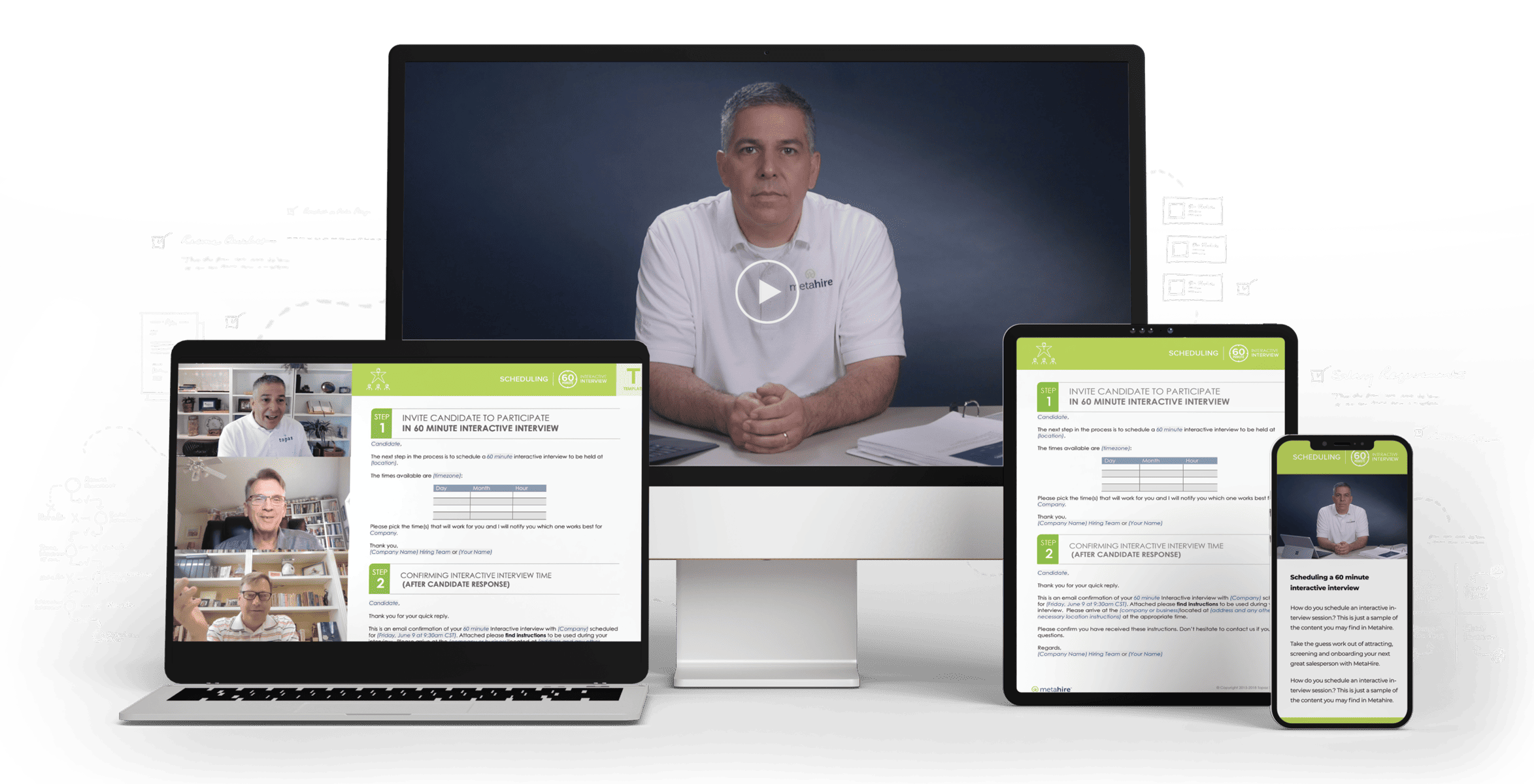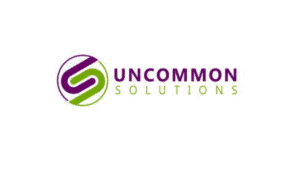Objections are a natural part of the sales process, but how well a sales professional navigates them can determine their success. We surveyed 1,000 sales professionals about their experiences with sales objections to uncover key trends, challenges, and best practices. The results offer a clear picture of where sales teams struggle and where they excel. More importantly, this article provides actionable Topaz Tips to help sales teams confidently overcome objections.
1. Frequency of Sales Objections
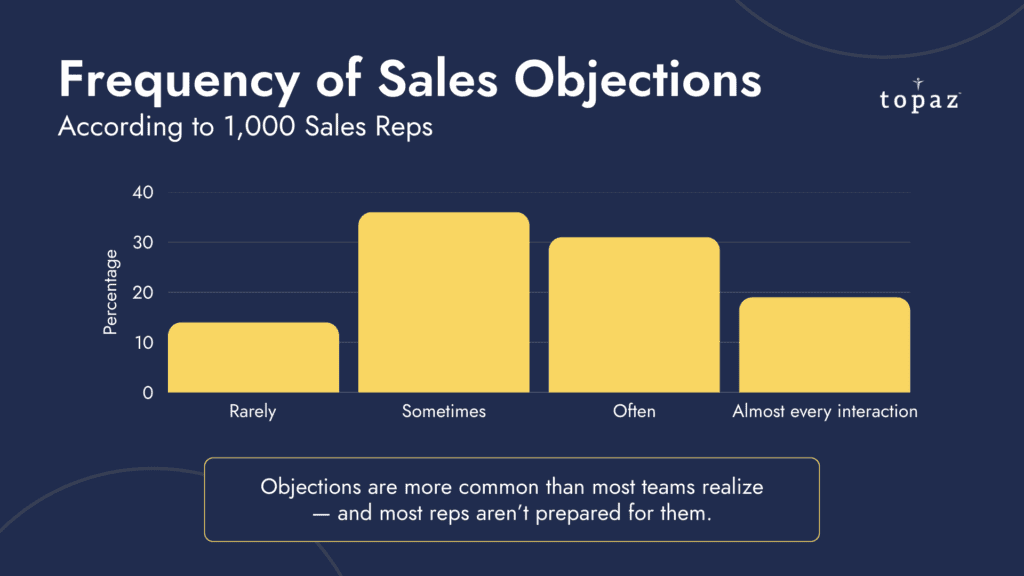
Survey Question: How often do you encounter objections during the sales process?
- 14% Rarely
- 36% Sometimes
- 31% Often
- 19% Almost every interaction
Example:
A professional services firm specializing in leadership development is presenting a custom coaching program to the executive team of a fast-growing tech startup. The CEO sees the value and wants to invest in developing leadership capacity across the company.
But as the conversation progresses, the COO interjects:
“This sounds helpful, but our leaders are already stretched thin. I’m worried they won’t have time to engage with this coaching process.”
The firm’s lead consultant responds a bit defensively:
“It’s only an hour or two a month—most leaders should be able to fit that in.”
The COO doesn’t seem convinced. The conversation loses momentum, and the deal stalls.
Topaz Tip:
Objections don’t always show up as resistance—they often come as concerns disguised as practicality. A Buyer Facilitator knows not to counter the concern with logic but to lean into it with curiosity and empathy.
“That’s completely fair—time is a major investment. Can I ask what kind of impact this program would need to have for your leaders to feel it’s worth their time?”
(This reframes the objection into a value conversation. Now the dialogue is about outcomes, not schedules. It also gives the COO an active role in defining success.)
2. Most Challenging Stage for Handling Objections
Survey Question: Which stage of the sales process do you find most challenging for handling objections?
- 24% Initial contact
- 31% Proposal/presentation
- 19% Negotiation
- 26% Closing the deal
Example:
A sales rep has been working with a mid-sized logistics company for several weeks, building a strong case for their supply chain optimization software. The decision-maker—the COO—has been engaged throughout the process, asking insightful questions and showing clear interest.
The sales rep enters the proposal review expecting to finalize the next steps, but suddenly, the COO says:
“We really like what we’ve seen so far, but we need more time to evaluate other options before making a decision.”
Topaz Tip:
A traditional salesperson might panic and try to rush the decision by applying pressure, saying, “What will it take to close this today?” But a Buyer Facilitator embraces infinite curiosity, turning the delay into an opportunity for deeper engagement.
“I completely understand—you want to make the best choice. When you say you need more time, what specific factors are most important to you in comparing solutions?”
(This moves the conversation from a vague ‘we need time’ to identifying the real decision-making criteria.)
3. Preparedness to Respond to Objections
Survey Question: How prepared do you feel to respond to common objections?
- 11% Not prepared
- 29% Somewhat prepared
- 41% Prepared
- 19% Very prepared
Example:
A residential contractor meets with a homeowner to discuss a whole-home renovation project. The client loves the vision, respects the contractor’s experience, and is excited about the transformation.
But as they review the proposed timeline, the homeowner says:
“We’re just not sure we can handle the disruption right now. We’ve got two kids in school, and I work from home. It feels like a huge inconvenience.”
The contractor, unsure of how to respond, says:
“I get it… remodeling is messy. We’ll do our best to be quick.”
The homeowner doesn’t feel reassured, and their enthusiasm starts to fade. The meeting ends with a vague “we’ll think about it.”
Topaz Tip:
Objections aren’t always about cost—they’re often about comfort, disruption, timing, or fear of regret. A Buyer Facilitator doesn’t gloss over those—they dig into them with empathy and curiosity.
“That makes perfect sense—this is a big decision, and your home is your sanctuary. Can I ask what kind of accommodations would make this feel less disruptive for your family?”
(Being prepared doesn’t mean having all the answers—it means having the right questions that move the conversation forward.)
4. Most Common Objections
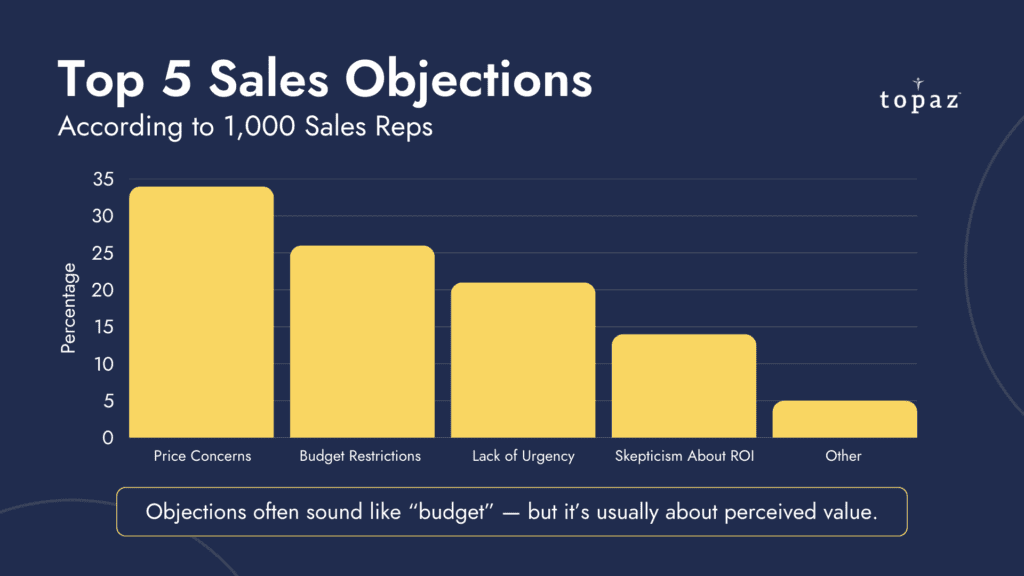
Survey Question: What types of objections do you encounter most frequently?
- 34% Price concerns
- 21% Lack of urgency
- 26% Budget restrictions
- 14% Skepticism about ROI
- 5% Other
Example:
A prospect says, “We don’t have the budget for this right now.”
Topaz Tip:
A traditional salesperson might react by trying to overcome the objection with urgency or by offering a discount. But a Buyer Facilitator knows that “budget” is often a placeholder objection—a polite way of saying, “I don’t see enough value yet,” or “I’m unsure this is a priority.” Instead of fighting it, they use curiosity to uncover the real roadblock.
“If budget weren’t a concern, would this solution be something you’d want to move forward with?”
(This question is key—if they say yes, then the issue isn’t really budget, but perceived ROI. If they hesitate, there’s another underlying reason to uncover.)
5. Confidence in Reframing Price-Related Objections

Survey Question: How confident are you in your ability to reframe price objections into value discussions?
- 16% Not confident
- 34% Somewhat confident
- 35% Confident
- 15% Very confident
Example:
A customer pushes back, saying, “Your competitor offers a similar product for 25% less.”
Topaz Tip:
A traditional salesperson might immediately defend their pricing or try to justify the higher cost. But a Buyer Facilitator approaches this objection with curiosity, differentiation, and value-focused conversation—rather than getting into a price war.
“I’d love to understand—when you compare our solution to theirs, what differences have you noticed?”
(This gets the prospect to articulate differentiators themselves, rather than the rep forcing a comparison.)
6. Effectiveness of Sales Training on Objection Handling
Survey Question: How effective is your current sales training at handling objections?
- 11% Not effective
- 42% Somewhat effective
- 35% Effective
- 12% Highly effective
Example:
A national healthcare services company has recently expanded its inside sales team. Leadership is focused on accelerating growth, so they implement a fast-paced onboarding program packed with product specs, compliance rules, and CRM processes.
Sales reps become quick at explaining what the service is, but when prospects push back with questions like “What makes you different from our current provider?” or “Why should we switch now?”, the reps freeze—or worse, give vague, scripted answers that don’t land.
Despite the training investment, conversion rates stay low, and deals consistently stall when objections surface.
Topaz Tip:
A traditional approach to sales training often assumes that product fluency equals selling ability. A Buyer Facilitator knows that the real skill is helping buyers move from uncertainty to clarity, which happens through objection handling.
Instead of training your team to memorize facts, train them to facilitate conversations around the buyer’s fears, resistance, and hidden questions.
Ask yourself:
- Does my team know how to uncover what’s behind an objection?
- Do they have a shared language and process for responding with confidence?
(Objection-handling is not a soft skill—it’s a core competency of modern sales.)
7. Impact of Objections on Closing Deals
Survey Question: How often do objections result in losing a sale?
- 21% Rarely
- 39% Sometimes
- 30% Often
Example:
A sales rep is in the final stages of closing a deal with a mid-sized manufacturing company. The decision-maker has shown strong interest, and everything seems to be moving forward—until the CFO steps in with a last-minute objection:
“We’re not sure we’ll see the ROI fast enough to justify moving forward right now.”
Topaz Tip:
A traditional salesperson might react with defensive justifications or push for a quick close. But a Buyer Facilitator remains calm, knowing that this isn’t a rejection—it’s an opportunity to guide the conversation toward clarity.
“I appreciate you bringing that up—it’s smart to ensure the investment makes financial sense. When you say you’re unsure about ROI, are you concerned about the timeline, the actual results, or something else?”
(This moves the CFO from a broad objection to a specific, solvable concern.)
8. Comfort in Asking Questions to Uncover Root Causes
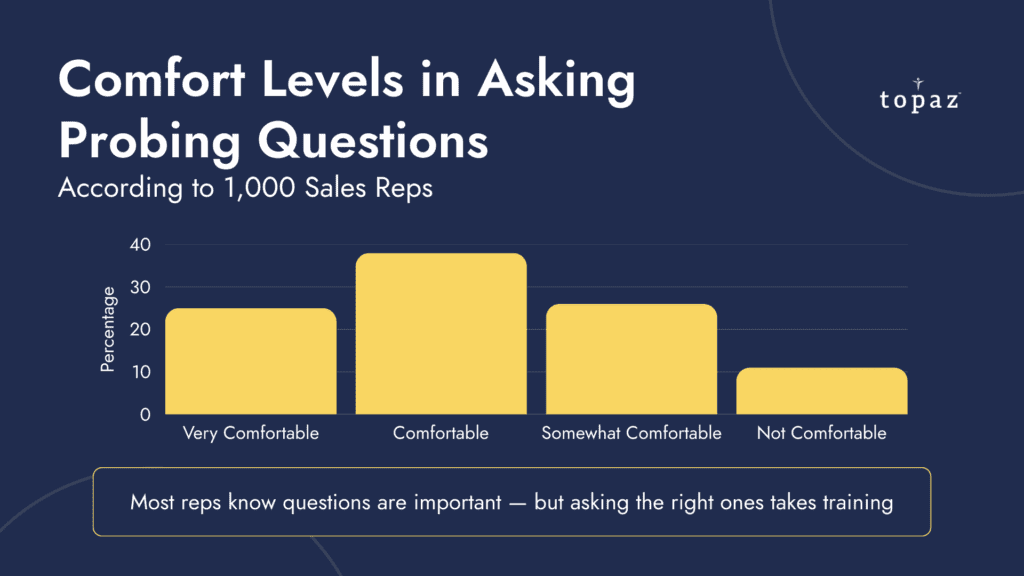
Survey Question: How comfortable are you with asking questions to uncover the real cause of objections?
- 11% Not comfortable
- 26% Somewhat comfortable
- 38% Comfortable
- 25% Very comfortable
Example:
A sales rep is on a call with a potential client who seems interested in their solution. However, when it’s time to move the conversation forward, the prospect says:
“This sounds great, but I don’t think we’re ready to make a change right now.”
Topaz Tip:
A traditional salesperson might either accept the delay at face value or try to push the deal forward aggressively, neither of which moves the conversation productively. A Buyer Facilitator, on the other hand, sees this as an opportunity to uncover the real hesitation and guide the prospect to clarity.
“I hear you—it’s important to make a change at the right time. Can I ask what specifically makes this feel like the wrong time for your team?”
(This question gently challenges the statement and invites the prospect to articulate the real blocker.)
9. Equipped with the Right Tools for Handling Objections
Survey Question: Do you feel equipped with the right tools or scripts to address objections?
- 16% Not equipped
- 29% Somewhat equipped
- 34% Equipped
- 21% Very well-equipped
Example:
A sales rep for an office furniture distributor is pitching to a CFO. The CFO says:
“I like your solution, but I’m not convinced that the ROI justifies the investment. We’ve used similar services in the past and didn’t see much impact.”
Topaz Tip:
A traditional salesperson might jump straight into defense mode, rattling off statistics or pushing a generic ROI claim. However, a buyer facilitator operates differently—through infinite curiosity and guided discovery rather than persuasion.
“I appreciate you sharing that. It sounds like ROI is a major concern for you, especially given past experiences. Can you tell me more about what didn’t work before?”
(This keeps the CFO engaged and opens the door for a deeper discussion instead of a debate.)
10. Most Effective Strategies for Overcoming Objections
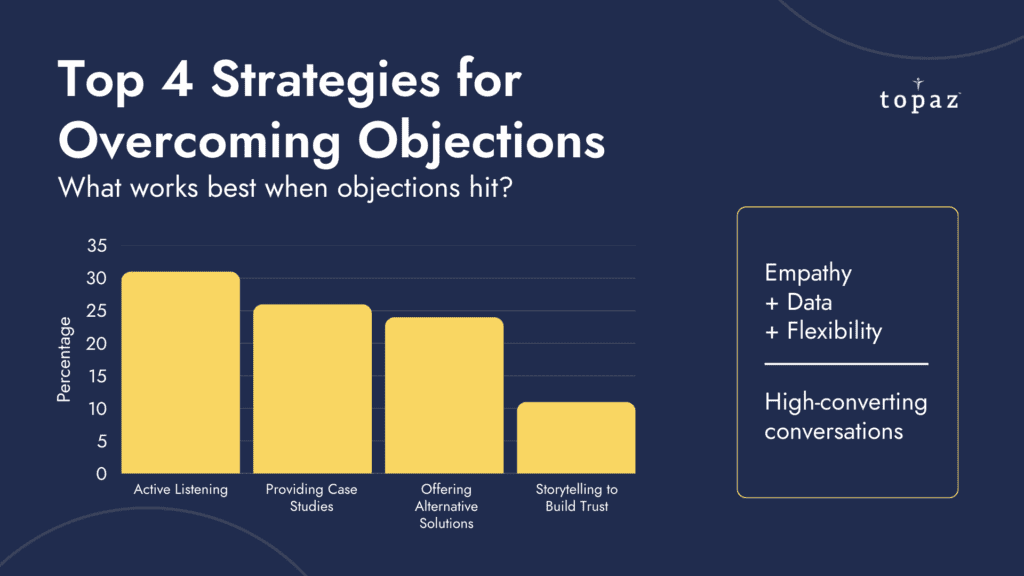
Survey Question: What strategies have you found most successful?
- 31% Active listening
- 26% Providing data or case studies
- 24% Offering alternative solutions
- 19% Building trust through storytelling
Example:
A B2B sales rep is pitching a high-end cybersecurity solution to a CIO. The CIO pushes back, saying, “Your solution looks great, but it’s 30% more expensive than our current provider. I don’t think I can justify the additional cost to my leadership team.”
Topaz Tip:
A traditional salesperson might immediately jump into discounting or defending the price. However, a buyer facilitator shifts the focus from cost to value, risk mitigation, and long-term impact, guiding the buyer to justify the investment on their terms.
“I completely understand—you need to ensure your leadership sees a clear return on this investment. Can we explore together what matters most to them when evaluating cybersecurity solutions?”
(This reframes the discussion from price to what drives the leadership team’s decision-making.)
Mastering Sales Objections: The Buyer Facilitator Approach
Sales objections are not roadblocks—they are opportunities to uncover deeper concerns, build trust, and guide buyers toward confident decisions. Yet, many sales teams struggle because they lack structured training on objection handling, focusing too much on product knowledge and not enough on the buyer.
Based on the survey results and creating real-world sales scenarios, we’ve highlighted how a Buyer Facilitator—instead of reacting defensively—guides conversations with curiosity, structure, and value-driven responses.
Mastering sales objections isn’t about arguing or convincing—it’s about guiding buyers through their decision process with clarity, confidence, and a relationship based on trust.
- When buyers feel heard, they engage.
- When buyers see value, price becomes secondary.
- When buyers have a roadmap, they move forward.
A Buyer Facilitator doesn’t just sell—they empower buyers to make the best possible decision. And when buyers feel empowered, deals close faster, with less friction, and at higher value.

